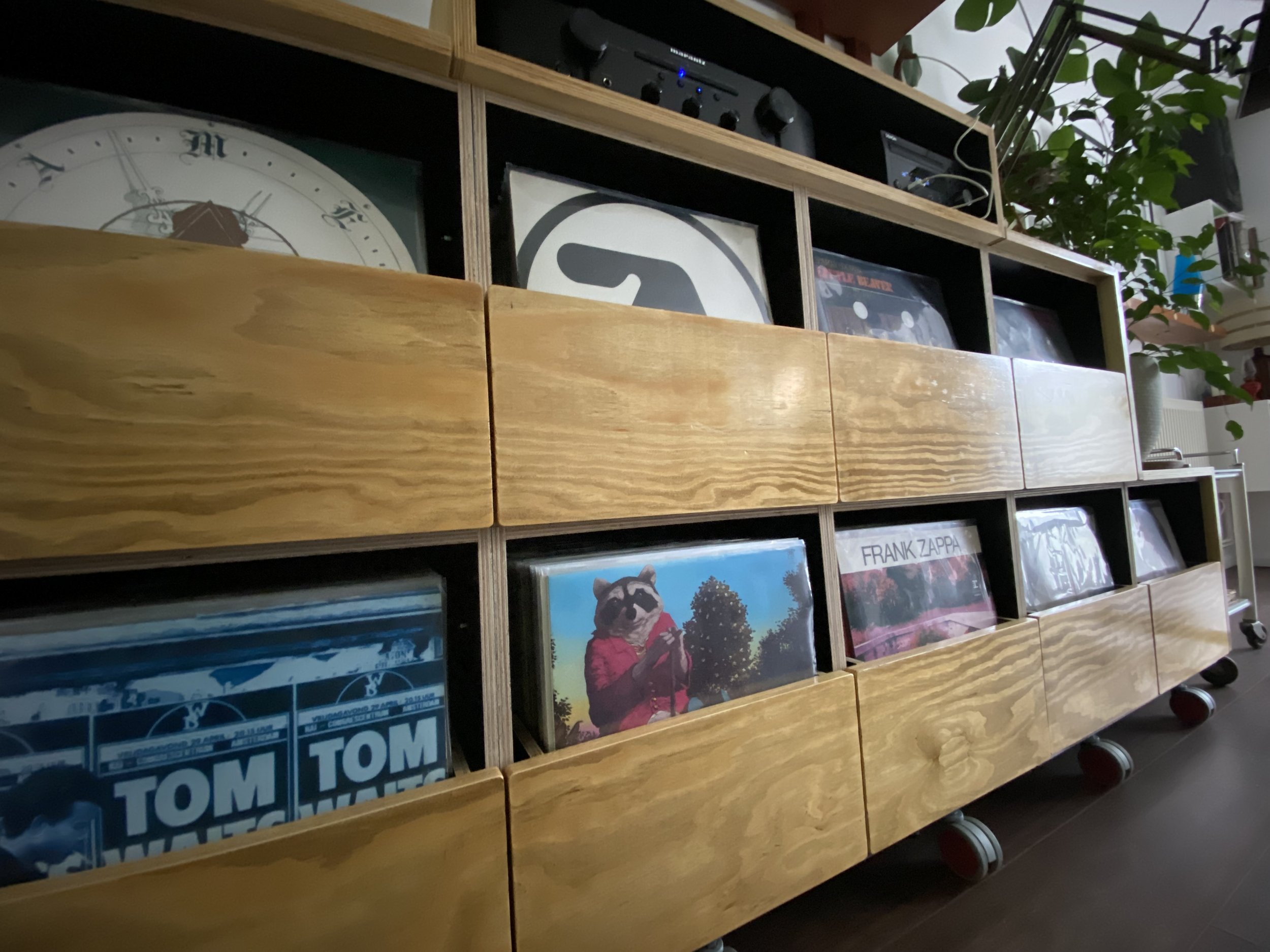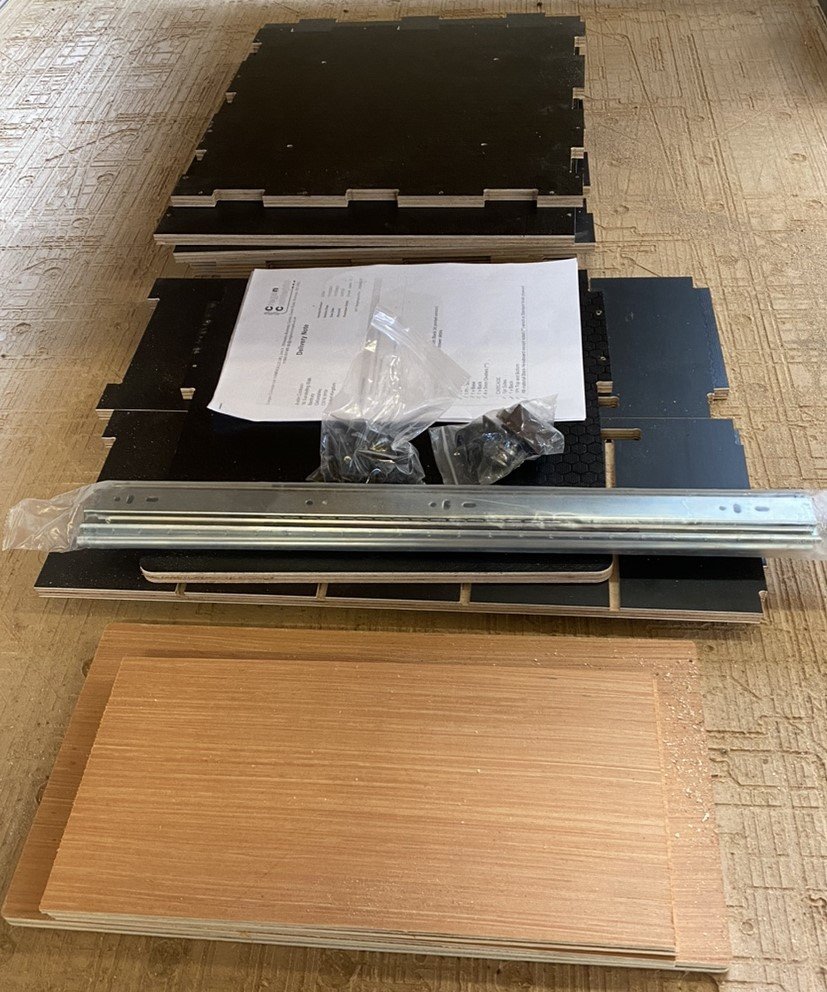
General Info…
Here you’ll find some general information to help you understand how these modules work, what you can do, and how to do it.
Instructions will be provided in each kit, and you can look at the ‘How To…’ page on this website for more comprehensive instructions and some useful video clips to help you construct your DMCs. Check out the ‘Projects, Tips & Ideas’ page too.
The main idea of these modules is to provide you with a basic unit which looks great and can be used immediately ‘as is’, but also provides a solid base framework from which you can develop a truly unique design for your own storage solution.
It’s a system which allows you to add modules as your collection expands (as they do..…) so you can start with a couple of basic units and then extend and develop as your ideas, collection, time and budget allows. The design possibilities are limitless and the range of materials which could be employed are endless. You could add handles, feet, wheels, lighting and cladding to the tops and sides. Anything you can imagine!
If you can imagine it, you can build it!
Each module is supplied as a flat pack kit which includes all the fittings and fixings you need to complete the construction.
Standard Drawer Module Carcass (DMC) dimensions - 403.4mm x 403.4mm x 513mm. The DMCs also come with 4 drop in drawer dividers which can be added or removed any time. Complete modules can easily be bolted together in almost any formation or design, and of course you can customise them in any way you choose. You can select black faced finishes or plain ply which can be painted, decorated or varnished.
We’re here to help, and it could be possible for us to supply units pre constructed if your budget allows. Get in touch to discuss the options if that feels right for you.
Constructing Modules.
Construction is relatively simple, but we advise you to take some time to understand how to achieve the best results. Like anything you make yourself, the better it’s constructed, the better it will look and perform. You don’t need to be a master carpenter, but it would be an advantage to have some basic DIY skills and be comfortable using hand and small power tools!
Guide screw holes are provided in all panels, and we advise familiarising yourself with their locations before you begin construction. When screwing the parts together make sure you drive the screw heads flush to the surface, this is important if you are joining multiple DMCs. Edges may be sharp, so a little sanding is advised both for comfort and for a fine finish.
It is advisable to offer up all the parts prior to fixing to establish if any adjustments are required. There are two elements to construct for each drawer unit - the outer carcass, and the drawer itself. Once both are completed you simply align and fit the drawer inside the outer carcass. Once installed, the drawers are removable at any time. A ‘push in -pop out’ locking catch is provided which is optional to fit. This acts as a simple catch lock to prevent opening of the drawers by little people!
Connecting Modules.
Connecting modules to create your design is simple. If you want to join units together in vertical or horizontal lines, you can just line up the provided pre-drilled holes and use nuts and bolts to join them securely. You can also use the provided holes to do a half, or third overlap in the same manor.
You could of course just screw them together with appropriately sized wood screws, but the holes provided work very well with M5 x30mm coach bolts, washers & nuts - washers are advisable to prevent overtightening and crushing the ply. We have found this to be the best method, and it also allows easy dismantling in future if you want to redesign and rebuild your creation.
If you choose to create a stack of modules it is essential that they are securely fixed to the wall behind to prevent the unit toppling forward when draws are opened.
If you’d like some help or advice about how best to arrange your modules into a complete unit, or for any queries, please get in touch, we’d love to hear from you!
Adding Bass!
Adding a base of some sort is not essential, but you will need to raise the units off the floor a little to allow the drawers to open freely. This can be as simple as a piece of plywood, MDF or timber. You could also fit feet or wheels to the base of each module or make a larger wooden base to accommodate multiple units.
We have devloped a simple wooden base which simply bolts directly to the bottom of each DMC and provides excellent support and a level platform.
Steel base frames can be supplied as special - order items.
There are several things to consider when choosing how you might support your own unit design. The first would be weight. Records are very heavy, and each drawer can hold well over 100 records. As you can imagine, if you choose to have multiple units, the weight can add up quickly. If you decide to add feet or wheels, you will need in ensure the selected feet or wheels can withstand the strain of the weight above, and the added leverage applied when drawers are opened. Keep in mind that one LP can weigh 220 grams, so a full drawer can weigh over 30 kilos! Thats a lot of weight! As a result, it’s absolutely essential that - as mentioned above - units are fixed to the wall behind using the holes provided in the back of each unit.
Tops, Shelves & Sides.
We have three elements here to get you started. Two tops’, a 2 module (2MT) and a 4 module (4MT). These are made from the same 12mm ply as the module carcasses and available in the same finishes. Each cover 2, or 4 modules with a 12mm overhang to the sides and front.
The Internal Shelf & side (INTs-S) element allows you to add an internal shelf 2 modules wide within a design, and also provides a 2-module high side panel which can be used in comination with a top.
Here again you can let your creative side take over. These tops, shelves and sides can be painted, waxed, oiled or decorated in any way you can imagine. You could even add Perspex or toughened glass to the tops too!
In addition to that you can add decorative elements by routing a shape to the edges or even fitting edge trims to truly make the design your own.
Safety Advice.
If you have a collection of vinyl, you already know how heavy records can be. This MUST be considered when you are developing your own storage unit! You are buying a kit, and it’s important to construct the modules correctly and carefully, taking your time, and understanding how they work. These modules are designed to be simple to construct, and over engineered to comfortably cope with the weight of full drawers in constant use. However, if you are considering stacking two or three units vertically, they MUST BE SECURELY FIXED TO THE WALL BEHIND to prevent toppling over as drawers are opened. (Holes are provided in the back plate). If you have three single units, stacked vertically, one on top of the other and you open the two top drawers, obviously it could fall over! Equally, weight distribution could play a part in stability, if you have more records in the upper drawers, and fewer in the lower ones, you could affect stability.
Common sense is the key here! We have experimented with various design layouts, and found the units to be very stable, but ultimately you are responsible for your own design and it’s stability and safety.
With our own 10 drawer unit we have taken the pyramid approach! This means that the bottom layer of drawers consists of 6 units, and the one above 4 units. Therefore, there will always be more weight and mass below than above. The entire unit is mounted on our steel base frames with heavy duty castors, which provides a super solid base (and allows easier moving, cleaning and cable management).
If you choose to add glass or perspex type materials to the tops, shelves or sides be sure you seek advice with regard to the safety of the materials you choose to utilise. Glass can be dangerous, and you must use toughened glass like that used on tabletops etc. Ask your local glass cutting service for advice before you proceed.
To sum up - Just use common sense when designing your own unit and consider the safety of your proposed design. Securely fix the units to the wall behind and consider how to distribute your records within the completed unit.
We’re more than happy to help you, so drop us a line with any thoughts, suggestions or queries.



















